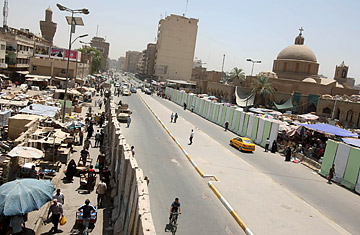
In Baghdad, blast walls protect a market where Iraqis buy groceries
Part 2 of TIME's Return to Baghdad series.
After all the time I've spent embedded with U.S. soldiers in Iraq, it seems only fair that one of them should now be embedded with me. Jonathan Rawlings, known as Nate, recently completed his studies at the Columbia University Graduate School of Journalism, but before that, he served two tours of duty in Iraq for the 4th Infantry Division.
We're in Baghdad on assignment for TIME, to report on how Iraq looks and feels after the withdrawal this past summer of U.S. combat troops. For me, this trip is also an opportunity to show a former soldier a side of this country that he could not have seen while in uniform: an Iraq that was my home for the best part of five years.
On my embeds, soldiers were often astonished that I, like most journalists, chose to live in the Red Zone, their term for parts of Baghdad outside the heavily guarded Green Zone and the military bases in and around the city. It seemed strange — or maybe just plain nuts — that any non-Iraqi would drive through the city's most violent neighborhoods in ordinary "soft-skinned" cars, usually without body armor and with no more than a couple of lightly armed guards.
Now Rawlings gets to experience that for himself.
To be sure, Baghdad is a lot safer now than, say, the summer of 2006, when the Shi'ite-Sunni civil war was at its peak and when even journalists thought long and hard before risking a ride through the city. Rawlings is a fearless fellow, and would have relished the chance to experience the Red Zone at its reddest. But I'm a shameless coward, and would have refused to take him along. Not just because he was a soldier — militant groups on both sides of the sectarian divide would have liked nothing more than to get their hands on a defenseless American serviceman — but also because he looks very much like a foreigner. My Indian origins allow me to pass for a local, which I thought was better than any armor. But in 2006 and '07, I was never more frightened than when traveling with a white American or European colleague.
These days, there are places in Baghdad that foreigners can visit, as long as they exercise appropriate caution. Rawlings and I are fortunate to have the guidance of Ali al-Shaheen, TIME's longtime Baghdad bureau manager and lead translator, who possesses the finest antennae for danger of any person I know. Al-Shaheen has saved my life more times than either of us care to remember, and has agreed to try to keep us out of trouble.
Al-Shaheen and I plan to show Rawlings some of the best and worst places we know: our favorite neighborhoods and hangouts, but also places where we've had hair-raising (and occasionally life-threatening) experiences. And through Rawlings' fresh eyes, I hope to find new ways of seeing these familiar locations.
It will be harder for Rawlings to show me his Iraq: many of the places he patrolled — Abu Ghraib, Khan Dhary and the region south of Baghdad known as the Triangle of Death — are still pretty dangerous, especially if you're not in a convoy of up-armored military vehicles. Our best hope for visiting these places may be to embed with Iraqi security forces. But are we brave enough for that?
